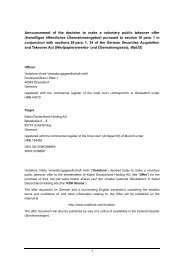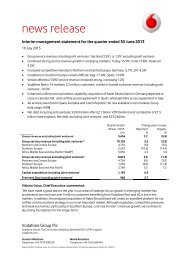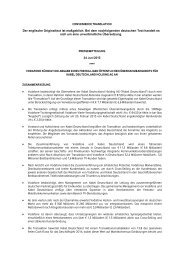You also want an ePaper? Increase the reach of your titles
YUMPU automatically turns print PDFs into web optimized ePapers that Google loves.
Moving the debate forward • The Policy Paper Series • Number 8 • April 2008<br />
expresses this point by saying “There are ‘decreasing returns<br />
to scale’ in predation: any further reduction in the small firm’s<br />
profits is bought at increasing cost for the large firm.”<br />
Second, all these models potentially over-state any benefit<br />
to large networks by assuming that, other than for on-net/<br />
off-net price differentials, subscribers will distribute their<br />
calls across all networks in strict proportion to network size.<br />
In practice this is not true. It is clearly not true in the business<br />
market where a high proportion of calls will be intra-company,<br />
and research shows that neither is it true in the consumer<br />
market where calls are concentrated to family and friends.<br />
For example, Birke and Swann (2007), 2 in the context of their<br />
study estimated that “ten million subscribers to a network<br />
have the same impact on consumer choice as one additional<br />
member from the same household being on the same<br />
network.” Thus the benefit of on-net calling is independent<br />
of network size. This is described in the paper by Jordi Gual<br />
as the difference between endogenous and exogenous<br />
network effects. To the extent that network effects are<br />
exogenous, they can be exploited in small networks as easily<br />
as in large networks.<br />
Third, realities of European mobile markets clearly<br />
demonstrate that on-net pricing has occurred during a period<br />
of increasing competition – counter to what one would expect<br />
if such tactics were indeed predatory. As we will see, on-net<br />
pricing has been practised by both large and small networks<br />
in Europe for over 10 years, and during that time the larger<br />
networks have progressively lost market share.<br />
On-net pricing can be traced back to the origins of network<br />
competition in Europe in the mid-1990s (see the accompanying<br />
paper “On-net Pricing in Mobile Services” by Teligen).<br />
Table 1 shows a strong correlation between the introduction<br />
of on-net pricing by established operators (e.g. T-Mobile in<br />
Germany) and entry of a new operator 6-18 months previously<br />
(e.g. E-Plus). In many cases, the new entrant has initiated onnet<br />
competition with the established operator following later.<br />
On-net and off-net price differentiation appears to be<br />
one of many tools that new and established MNOs use to<br />
engage in increasingly intense competition. On-net pricing<br />
On-net Pricing in Mobile<br />
is firmly established as part of a competitive landscape, in<br />
which new entrants have consistently gained market share<br />
at the expense of existing networks. This appears to fit the<br />
theoretical results discussed in the paper by Dan Elliott<br />
earlier in this pamphlet, which show that on-net/off-net price<br />
differentials intensify competition between MNOs.<br />
One of the principal indicators of the extent of competition<br />
in a market is the HHI (Herfindahl-Hirschman Index 3 ) –<br />
a measure of market concentration. Chart 1 shows the<br />
average HHI4 for the European mobile sector as a whole from<br />
2001. On average, the HHI has fallen as new entrants have<br />
gained market share. The HHI has risen at particular points<br />
in time in particular markets (for example immediately<br />
following a merger), but the general pattern of a falling<br />
HHI (and increasing competitiveness) is clear.<br />
Chart 1:<br />
Table 1: Examples of introduction of on-net price differentiation by established operators<br />
3,700<br />
3,600<br />
3,500<br />
3,400<br />
3,300<br />
3,200<br />
3,100<br />
Average HHI in EU 25<br />
Q2 2001<br />
Q3 2001<br />
Q4 2001<br />
Q1 2002<br />
Q2 2002<br />
Q3 2002<br />
Q4 2002<br />
Q1 2003<br />
Q2 2003<br />
Q3 2003<br />
Q4 2003<br />
Q1 2004<br />
Q2 2004<br />
Q3 2004<br />
Q4 2004<br />
Q1 2005<br />
Q2 2005<br />
Q3 2005<br />
Q4 2005<br />
Q1 2006<br />
Q2 2006<br />
Q3 2006<br />
Q4 2006<br />
Q1 2007<br />
Q2 2007<br />
Q3 2007<br />
Q4 2007<br />
On-net pricing has been a feature of the mobile market<br />
throughout this period of falling HHI.<br />
While on-net pricing has occurred during a period when<br />
the average HHI in the European mobile market has been<br />
decreasing, one may argue that this fails to disprove that<br />
on-net pricing in a particular country has resulted in less<br />
competition. Such an argument, however, is not supported<br />
by the facts. Chart 2 shows that there is no correlation<br />
between on-net pricing and the HHI in any European country. 5<br />
That is, whether a particular country has on-net pricing or<br />
not, plays no part in determining the level of competition in<br />
its mobile market.<br />
Established MNO on-net pricing Launch of new network<br />
Germany Jul-95 (T-Mobile) May-94 (E-Plus, with on-net pricing)<br />
Norway Oct-95 (Telenor) Sep-93 (NetCom)<br />
France Jul-97 (SFR) Jan-96 (Bouygues)<br />
UK Jan-98 (<strong>Vodafone</strong>) Sep-93/Apr-94 (One2One/Orange, with on-net pricing)<br />
Ireland Jun-99 (Eircell) Mar-97 (Digicell, with on-net pricing)<br />
Spain May-99 (Movistar) Jan-99 (Amena)<br />
Italy Mar-00 (TIM) Mar-99 (Wind)<br />
Sources: Teligen (Established MNO pricing)<br />
GSMA (launch dates)<br />
Previous Frontier Economics report for <strong>Vodafone</strong> (new network pricing)<br />
37

















